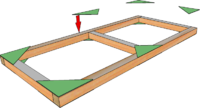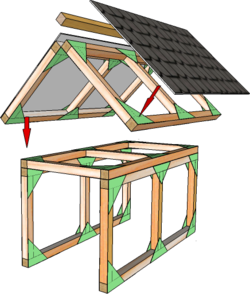Vinea: Difference between revisions
From DT Online
mNo edit summary |
mNo edit summary |
||
| Line 20: | Line 20: | ||
=====Making a Vinea===== | =====Making a Vinea===== | ||
Models of '''Vineae''' can be made using '''[[:Category:Stripwood Technology|Stripwood Technology]]''' techniques with card and 8mm x 8mm square timber. Start by making | Models of '''Vineae''' can be made using '''[[:Category:Stripwood Technology|Stripwood Technology]]''' techniques with card and 8mm x 8mm square timber. Start by making 5 identical basic flat frames, each 210mm long and 100mm high : | ||
[[File:VineaAssemble.png|250px|right]] | [[File:VineaAssemble.png|250px|right]] | ||
| Line 33: | Line 33: | ||
* Add a 210mm long strip of wood as a ridge | * Add a 210mm long strip of wood as a ridge | ||
* Search for suitable textures using the internet ''(e.g. search for 'woven twigs' using Google Images)'' and print-out on to thin card. | * Search for suitable textures using the internet ''(e.g. search for 'woven twigs' using Google Images)'' and print-out on to thin card. | ||
* Cut card rectangles to cover roof panels ''(and sides if required)'' glue in place. | * Cut card rectangles to cover roof panels ''(and sides if required)'' then glue in place. | ||
* Alternatively add card and paint to simulate woven twigs or layers of animal skins. | * Alternatively add card and paint to simulate woven twigs or layers of animal skins. | ||
Revision as of 14:02, 2 March 2018
Introduction
Vineae (plural) were a lightweight wooden construction, usually about 2.5m wide, 5m long and 2m high. Legionaries were able to lift them and move them together in a row towards the enemy wall. They were covered with panels of woven twigs to give protection from archers. The roofs may have been reinforced with a double layer of timber boards to protect against large stones being hurled at them from above. The entire exterior would be covered with wetted animal skins to protect against fire arrows.
The Romans were able to create protected corridors by joining several of these together. This enabled them to get close to fortification walls and undermine them or build ramps up to them.
The open front would be protected by large portable shields or Mantelets to protect those at the front and larger versions were built, which were known as Plutei These too were used to get near to enemy walls.
The illustration opposite shows a Vinea up against the wall on the left and a Pluteus on the right. In the foreground is a very light weight Vinea which the troops inside could pick up and carry forward.
Making a Vinea
Models of Vineae can be made using Stripwood Technology techniques with card and 8mm x 8mm square timber. Start by making 5 identical basic flat frames, each 210mm long and 100mm high :
- Draw the frame full-size on centimetre squared paper
- Hold strips of timber in a small Clamp-on Vice and cut to length using a Junior Hacksaw.
- Assemble the strip together by placing them over the drawing
- Glue 30mm x 30mm triangles of medium thickness card over each join as shown
- Turn the frame over and add card triangles to the opposite side
- Assemble the frames together and glue with P.V.A. glue
- Add a 210mm long strip of wood as a ridge
- Search for suitable textures using the internet (e.g. search for 'woven twigs' using Google Images) and print-out on to thin card.
- Cut card rectangles to cover roof panels (and sides if required) then glue in place.
- Alternatively add card and paint to simulate woven twigs or layers of animal skins.
Activity: Find out about Roman Siege Equipment (e.g. Vinea, Pluteus, Mantele, Testudo, Musculus, Helepolis, Turris, Corvus, Ballista (aka Scorpion), Onager, Aries (aka Battering Ram) and construct a working model or models using Stripwood Technology.



